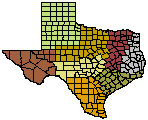- Trans Pecos
- High Plains/Panhandle
- Cross Timbers
- Hill Country
- Post Oak Savannah
- Pineywoods
- Oak Prairie
- South Texas Plains

Wildlife Division District Map
West Texas Wildlife Management
Nongame Wildlife
Nongame animals encompass a wide variety of species, some of which, such as rabbits, and bobcats, may be hunted. Others, like song birds, raptors (birds of prey), and state threatened and endangered species, including the black bear may not be hunted.
West Texas is known for its phenomenal scenery and breath taking vistas as well as for its unique hunting opportunities with game species such as Gambel's quail occuring no where else in the state. Opportunities for quality mule deer and pronghorn such as can be found in the Trans Pecos are hard pressed to be be matched anywhere else. Local economies depend on income associated with hunting. Landowners are learning that they can acquire additional income from bird watchers and other outdoor enthusiasts. Spring bird migration is a great time to visit the Trans Pecos for a chance to see many species of neotropical migrants, including a variety of warblers, vireos, and a plethera of hawks. This activity also contributes significantly to local economies. Believe it or not, there are many wildlife enthusiasts whom also enjoy opportunities to see reptiles and other nongame species.
As mentioned on the Endangered Species page, the existence of many nongame species is threatened by changing land-use practices. Game species have characteristics that allow them to withstand more harassment. For example, game species tend to be more productive. A quail or turkey hen may lay 14 eggs each year, whereas warblers may lay only 3 or 4 eggs. Game and nongame wildlife often differ in mobility and tolerance of environmental changes. We often think of mourning dove as tree-nesting birds; however, they also nest on the ground in areas absent of trees. This is a good example of how game species are not so habitat specific, and can adapt well to changing environments. Having said that, there are limits! Quail seldom nest on the beach, or a golf course, or a coastal bermuda pasture. Species that once were hunted, are now endangered (e.g., Attwater's prairie chicken) because of hunting pressure combined with losses of suitable habitat. While hunting can be stopped immediately, habitat restoration and improvement may take decades. We must manage our natural resources responsibly, to benefit the entire ecosystem.
Diversity equals productivity. The more diverse a site is, the more the ecosystem will benefit. Excellent black-capped vireo habitat is great for many other species of wildlife. The same can be said for bobwhite quail habitat. Rather than managing habitat for single species, focus on managing for communities. More on sound wildlife/range management.